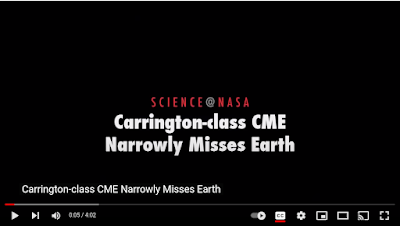
Later today the earth is expected to receive a glancing blow from an X5 Solar flare which launched a CME (Coronal Mass Ejection) from a sun spot on the incoming limb of the sun. While this is the strongest solar flare recorded since September of 2017, the CME is not aimed directly at earth, and NASA is only predicting a minor (G1) solar storm today.
The sun is capable of launching much larger, and far more impactful, space weather in our direction of course. But fortunately, like great earthquakes (8.0+), and severe pandemics, truly destructive solar flares and CMEs are exceedingly rare.
This is a topic that we've revisited a number of times over the years (see below), primarily due to the impacts they could have on our modern electrical infrastructure (see NIAC: Surviving A Catastrophic Power Outage).
Executive Order: Coordinating Efforts to Prepare the Nation for Space Weather Events
The UK’s Space Weather Preparedness Strategy
NASA: The Solar Super Storm Of 2012
Last spring, in FEMA: Preparing the Nation for Space Weather Events. we looked at a free online training course - for emergency managers and the general public - on preparing the nation for space weather events.
Our sun goes through a roughly 11-year cycle, over which time solar activity (sunspots, flares, Coronal Mass Ejections (CMEs), etc.) build to a maximum, and its magnetic field reverses, and then tapers off to a low activity minimum.
The following NOAA graphic shows the suns progress over solar cycle 24 between 2010 and 2020.
The sun hit its last solar maximum peak in 2014, and then slowly grew quieter with each passing year. That is, until a couple of years ago, when we started seeing increased signs of solar activity.
The sun entered solar cycle 25 in December of 2019 (see Solar Cycle 25 Is Here. NASA, NOAA Scientists Explain What That Means), and is inexorably moving towards a new solar maximum (in the next 18-24 months)
While it has been more than 20 years since our last major storm, as we learned in 2014 (see NASA: The Solar Super Storm Of 2012), we narrowly escaped being hit again in 2012. You can view a 4-minute video on our `near-hit' here.
Extreme solar events were once thought to occur only once every few hundred years, but scientists now believe that these severe solar storms happen far more often (See Destructive Solar Storms Usually Hit Earth Every 25 Years or So, Say Scientists).
FEMA takes these solar storms seriously, and has held several table-top exercises on this type of disaster. A 30 page PDF file is available for download from the Homeland Security Digital library on this exercise which envisioned a `near worst-case scenario’.
(excerpt)
Space weather describes the conditions in space that affect earth and its technological systems. Space weather is a consequence of the behavior of the sun, the nature of earth’s magnetic (geo- magnetic) field and atmosphere, and our location in the solar system. The active elements of space weather are proton particles, electromagnetic energy, and solar wind that effects earth’s magnetic field, rather than the more commonly known weather contributors of water, temperature, and air. Hurricanes and tsunamis are dangerous, and forecasting their arrival is a vital part of dealing with severe weather. Similarly, space weather forecasters monitor the sun to assist users in avoiding or mitigating severe space weather. These are storms that originate from the sun and occur in space near earth or in the earth’s atmosphere.
Most of the disruptions caused by space weather storms involve technology. Susceptible technology is quickly growing in use. Satellites, for example, carry weather information, military surveillance, TV and other communications signals, credit card and pager transmissions, navigation data, and cell phone usage. With the rising use of technologies, vulnerability to space weather events has increased dramatically.
Most people, unfortunately, think of an severe solar storm as nothing more than a plot device for a cheesy made-for-cable sci-fi movie. But the reality is, space weather presents a genuine national (and global) threat.
While I don't think anyone can prepare for the absolute worst-case scenario, the good news is that is very unlikely to happen. More likely are regional power or communication outages, possibly lasting days or even weeks.
Whether due to an earthquake, a hurricane, or a solar storm - being prepared for one just makes good sense.
So . . . if a disaster struck your region today, and the power went out, stores closed their doors, and water stopped flowing from your kitchen tap for the next 7 to 14 days . . . do you already have:
- A battery operated NWS Emergency Radio to find out what was going on, and to get vital instructions from emergency officials
- A decent first-aid kit, so that you can treat injuries
- Enough non-perishable food and water on hand to feed and hydrate your family (including pets) for the duration
- A way to provide light when the grid is down.
- A way to cook safely without electricity
- A way to purify or filter water
- A way to stay cool (fans) or warm when the power is out.
- A small supply of cash to use in case credit/debit machines are not working
- An emergency plan, including meeting places, emergency out-of-state contact numbers, a disaster buddy, and in case you must evacuate, a bug-out bag
- Spare supply of essential prescription medicines that you or your family may need
- A way to entertain yourself, or your kids, during a prolonged blackout




